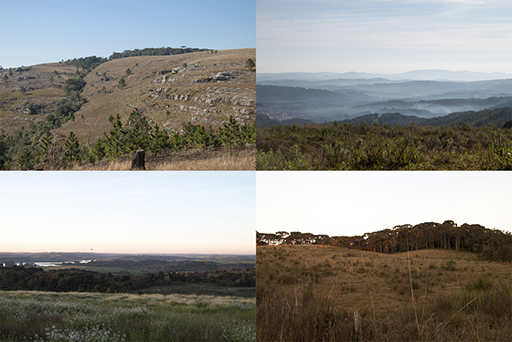
egion on the eastern edge of the Second Paranaense Plateau. It is characterized by the occurence of broad stretches of open fields (grasslands), isolated wooded groves and woods in strips along rivers and streams, which reflect the geological structure and the nature of the rocks, and are responsible for shallow, sandy soil.
The definition based on natural criteria was adopted initially by Reinhard Maack in 1947. According to Maack, the vegetation in this countryside was left over from a colder and drier paleoclimate of the Pleistocene. With the end of glaciation, about 12,000 years ago, the semiarid climate was substituted by a rainy period which gave rise to the forests.
In Campos Gerais, the grassland vegetation, with its forest groves, remain as a kind of relic, a remainder of the ancient climate. In some areas of the region (Jaguariaíva and Sengés) there exists flora typical of tree-covered savannahs or shrubby steppes, and in Tibagi there are preserved fragments of savannah, as in the area of Guartelá State Park.Besides grasses, the rocky outcroppings are home to rosemary-of-the-field, queen-of-the-abyss (Sinningia leucotricha, also known as Brazilian Edelweiss), carqueja (Bacharris trimera, a shrub), vassoura (Baccharis dracunculifolia), amaryllis, barbatimão (Stryphnodendron adstringens), orchids and bromelias. There are other species common to the region, like globular cactus. Mosses and lichens predominate in the wet outcroppings, which provide an environment for sempervivensand carnivorous plants. The groves are dominated by the araucárias, but there is room for cinnamon, imbuia, jacaranda, Santos rosewood, monjoleiro (Senegalia polyphylla) and cedro-rosa (Cedrela fissilis), most of which are nearing extinction, due to excessive lumbering in the XX century. Another characteristic of the landscape is the existence of solitary araucarias in the open fields surrounding the groves.
Fauna in Campos Gerais includes deer, many kinds of wild cats, maned wolves, pampas foxes, anteaters, howler monkeys, armadilloes, and capybaras.There are hawks, woodpeckers, partridges, and many other birds. There is a great variety of snakes and lizards.
The area has no well-defined borders, but Campos Gerais is considered to be the stretch of land between the Itararé River (the border with São Paulo in the Sengés municipality, and the Negro River, the border with Santa Catarina in the Rio Negro municipality. The Devonian Escarpment is the natural eastern border, but the municipalities of Castro and Piraí do Sul, both of which are situated on the First Plateau, are included when the area is studied by historians interested in human occupation and economic exploitation of the region. To the west, the region stretches to where the open fields take over.
The 84 square mile Campos Gerais National Park covers parts of the Ponta Grossa, Castro, and Carambeí municipalities. The Park was created in March of 2006 to preserve the marvelous and irreplaceable natural and cultural heritage of the region.
click on picture
to enlarge